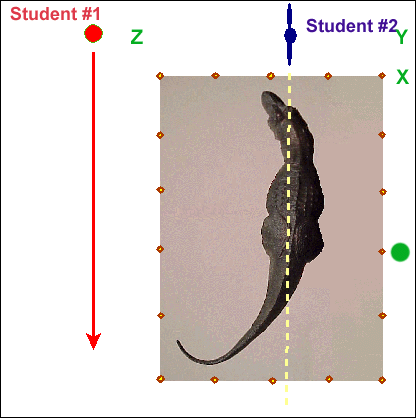|
Brooklyn College City University of New York |
Page1 |
 |
| Measuring distances by photoscanning is probably the simplest method of remote measurement that can be used for measuring the Museum's tyrannosaur. However, it requires two people working as a team, and it requires the use of a small one-time flash camera of the type sold in grocery and drug stores for about $8. The method has the advantage that you obtain a photographic record of your work for later reference and you don't need to do the calculations needed for triangulation.The figure below is an overhead view of the tyrannosaur. |
| 1. Student #2 stands with arms outstretched so that he/she is in line with the midplane
of the tyrannosaur's body (yellow dashed line).
2. Student #1 stands facing student #2, and with the one-time flash camera, takes a photo of student #2 and as much of the tyrannosaur as possible. 3. If the entire specimen does not fit into the picture, student #1 moves along the red line parallel to the midplane of the tyrannosaur's body, snapping overlapping photos of the tyrannosaur. When taking pictures, student #1 must be directly facing the point opposite him/her on the tyrannosaur's body. Turning right or left will give distorted images and inaccurate results. Do this until the entire body is photographed. | 
|
| 4. Measure the distance between the outstretched fingertips of student #2 with a
meterstick or tape measure (measurements in metric system only). This should actually be
done before you arrive at the Museum.
5. Have the film developed into prints. 6. When you have the prints, do the following. On the picture showing Student #2, measure the distance on the photo between his/her fingertips. The result can be used as a scaling factor with which you can scale tyrannosaur body dimensions on the photos to actual distances on the real tyrannosaur. To illustrate, suppose the actual fingertip distance of student #2 is 1.5 m, and on the photograph fingertip distance is 2 cm. Then you know that 2 cm on the photos equals 1.5 m on the real specimen. Suppose you find that the total length of the animal (nose to tip of tail) on the pictures is 20 cm. What is the actual length of the animal? If you are not sure email me. 7. Be careful about indiscriminately photographing the tyrannosaur, especially if the photo-taker (student #1) moves to a new location to do a new series photos. For example, to get a good picture of the right foot and right leg, suppose you (student #1) find it necessary to move to a new point, shown in green in the figure above, opposite the tyrannosaur's right leg . You are now at a distance from the specimen that is different than in the original series of photos done along the red arrow. The scaling factor (fingertip distance) determined for this first series of photos will now not apply. You will thus have to take a new picture of student #2 in which you (student #1) stand at distance from student #2 that is equal to the distance between the green dot and the tyrannosaur's leg. Assuming student #2 doesn't move, where would you stand to make a new photo of student #2 that would serve as a scaling instrument for this new series of photos taken from the point represented by the green dot - point X, Y, or Z? If you're not sure email me. |

|